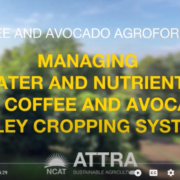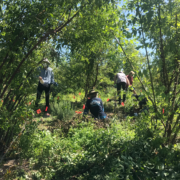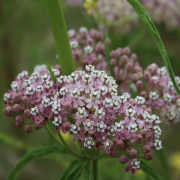Agroforestry for Improved Soil Fertility
 Print This Post
Print This Post
By Katherine Favor, NCAT Sustainable Agriculture Specialist
It’s the holiday season, the time of year when food and feasting is at the forefront of our thoughts more than ever. Just like humans, our soil needs nutrition, too, so while part of me is busy thinking about what food I’m going to make for my family this Christmas, the other part of me is thinking about what food my soil needs.
Managing crop nutrition can be tough and building long-lasting healthy soil can be even tougher. We often talk about the more common tools for managing soil fertility, such as fertilizers, compost, cover crops, green manures, no-till farming, rotational grazing, etc. But did you know that utilizing trees in your cropping system through agroforestry can also be a tool for building healthy and fertile soil?
Agroforestry is a regenerative farming practice defined as the intentional combination of trees with crops and/or livestock into a single, integrated system. Agroforestry can take many forms – from rotating animals through an orchard; to alley cropping rows of crops between rows of fruit, nut, or timber trees; to planting rows of windbreaks along the edges of your property; to planting shade-tolerant crops under the shade of a managed forest or orchard; and so much more. No matter what your agroforestry system looks like, incorporating trees improves soil fertility by increasing organic matter, boosting microbiological activity, mineralizing nutrients into a more plant-available form, cycling nutrients up from deep soil layers to shallow ones, fixing nitrogen (in the case of leguminous trees), and preventing nutrient losses due to leaching, erosion, and runoff.
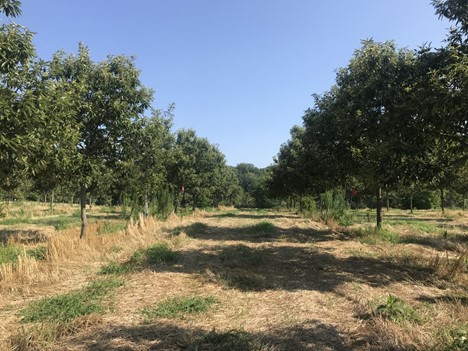
A wheat and chestnut agroforestry alley cropping system in Missouri. Photo: Katherine Favor, NCAT
Trees significantly increase soil organic matter in a cropping system – by 50-100% in many cases – through prunings, litterfall, root slough, and exudates (Young, 1989). This additional organic matter serves as increased food for microbes, which, in turn, boosts soil microbiological activity by up to 30% (Young, 1989). Increased microbiological activity causes increased mineralization and decomposition of nutrients, allowing nutrients in the soil to be more easily absorbed by plants, resulting in higher plant nutrient uptake (Paudel et al., 2011). The increased soil organic matter that trees add to farms also results in higher cation exchange capacity in soils, which allows soils to better hold on to applied nutrients and to resist nutrient leaching (Young, 1989).
Trees also draw nutrients up from deep soil profiles to shallow soil profiles. Their roots, with the aid of the fungal associations connected with those roots, dissolve and absorb nutrients that are deep underground. Once absorbed, trees convert those nutrients into biomass such as leaf litter, branches, and shallower roots, which eventually fall and/or decompose in upper soil layers, thereby increasing nutrient content in areas where crops are. In the case of nitrogen-fixing leguminous trees, trees are also able to turn nitrogen gas from the atmosphere into solid ammonia (NH3) in the soil.
Another way that trees help manage soil fertility is by preventing nutrient losses that occur through erosion, leaching, and runoff. One way that trees do this is by improving soil structure (i.e., increasing porosity, water-holding capacity, and infiltration). This occurs through a couple of mechanisms:
- Trees break up compacted soils with their roots and leave behind hollow root channels that allow water and air to enter, keeping soil porous and fluffy. When water is able to seep into the soil, it doesn’t run off the soil surface or carry soil nutrients with it as it does so. Less runoff = more nutrients and water that stay in the soil.
- Trees shed organic matter in the form of prunings, litterfall, root slough, and exudates, which all increase both soil organic matter and microbiological activity. Soils with high organic matter clump together and form sticky soil aggregates, which not only increase soil infiltration capacity and water holding capacity, but which also stick together more easily, thus resisting erosion better.
Trees also protect soil from the kinetic forces of wind and rain, which are the most common culprits of soil erosion. Most of the time, soil erosion is caused by wind, when wind energy dislodges soil particles from the soil surface, and when those dislodged particles subsequently dislodge other particles through a process called saltation. Trees slow wind, significantly reducing soil erosion and keeping those nutrients on the farm. Soil erosion is also caused by rain, when rain falls on bare soil and the kinetic force of raindrops dislodges soil particles and carries them away in the form of runoff. Agroforestry systems prevent this from happening because litterfall from trees provides a mulch layer of twigs and leaves on the ground that protects soil from kinetic impact, thereby preventing soil particles from washing away.
The protection from kinetic impact and the improved soil structure that trees provide in agroforestry systems results in less erosion, leaching, and runoff. This means that when nutrients are added to a farm in the form of fertilizers, those applied nutrients stay in the soil. That translates to more bang for your buck if you’re a farmer who’s buying inputs, and it means cleaner watersheds downstream, too.
While agroforestry systems increase soil fertility, it is important to note that trees can also compete with crops for nutrients. It is important to minimize competition for nutrients as much as possible by:
- Being selective about your tree/crop combinations. Which trees are you pairing with your crop? Ideally, trees should have root systems that are deeper than your crops’ roots, so that they are able to occupy different soil niches. Selecting nitrogen-fixing trees can also be a good strategy for reducing competition for nutrients, as long as those trees fit into your overall farm production goals.
- Designing your spacing so that trees are not too close to your crop. The ideal spacing will vary depending on your system and on the types of trees and crops that you’re planting, so it’s important to research what works best for your particular system.
- Root pruning. In some cases, it makes sense to prune large tree roots in the upper soil profiles only, to prevent them from overlapping with your crop roots. Root pruning encourages tree roots to grow down and deep, rather than out horizontally into your crop roots’ space. It can be done by trenching or deep disc ploughing, using tractor-drawn implements. Typically, pruning tree roots in the upper two to three feet of soil is enough to prevent most competition for nutrients.
Managing soil fertility and crop nutrition can be tricky but incorporating trees into your farm through agroforestry can be a great way to help you do it. If you manage competition between trees and crops for nutrients, you will be able to capitalize on the soil fertility benefits that trees provide to a farming system. For more information about agroforestry, check out our resources, or reach out to one of NCAT’s Sustainable Agriculture Specialists today.
References:
Paudel, B, R.P. Udawatta, R.J. Kremer, and S.H. Anderson. 2011 Soil quality indicator responses to row crop, grazed pasture, and agroforestry buffer management. Agroforestry Systems 82: 311-323.
Young, A. 1989. Agroforestry for Soil Conservation. 1st Edition. Oxford University Press.
Related ATTRA Resources:
Vineyard Agroforestry: Growing Grapes in the Era of Climate Change
Episode 187. Perspectives on Agroforestry with Rowan Reid. Part 1
Episode 187. Perspectives on Agroforestry with Rowan Reid. Part 2
Other Resources:
Favor, K. 2021 Chapter 4: Below-Ground Services in Vineyard Agroforestry Systems. In: Udawatta R, Jose S (eds) Agroforestry and Ecosystem Services. Springer International Publishing.
This blog is produced by the National Center for Appropriate Technology through the ATTRA Sustainable Agriculture program, under a cooperative agreement with USDA Rural Development. ATTRA.NCAT.ORG.

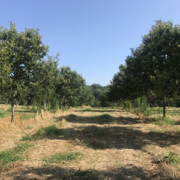


 wikicommons Zeynel Cebeci
wikicommons Zeynel Cebeci